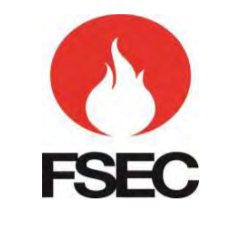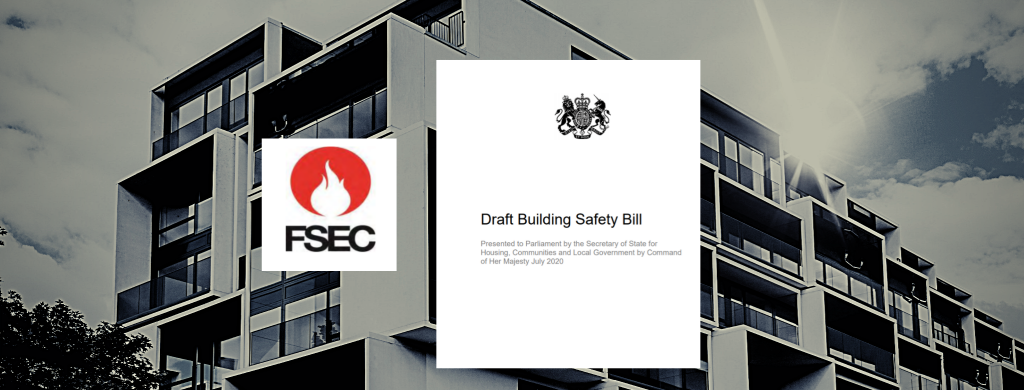Posted by Peter Bailey
Senior Fire Engineer FSEC Ltd and group of companies
Re New Fire safety Bill to be introduced hopefully in 2021
There has been pressure and massive interest following the Grenfell Tower fire in 2017. In response to this Dame Judith Hackitt chaired an independent review of building regulations and fire safety which has led to the new proposals being put forward.
The Draft Building Safety Bill follows the government response to the Building a Safer Future recommended by Dame Judith Hackitt.
The government has accepted her recommendations, and the Draft Bill will set out how Consultants like FSEC can assist and ensure the value for money and real-life safety improvements in building and life safety.
The Draft Building Safety Bill allows the government to introduce welcome, long needed reforms to the service and maintenance of the fire precautions’ and equipment in all buildings, especially high risk and complex buildings.
In the FSEC team we have 200 years’ experience in real operational firefighting (at officer and senior level) and fire safety enforcement. We have seen so many design and maintenance failures of smoke control equipment that is required for life and building safety to make the team collectively consider that:
- There are more systems that are in functional failure than are correctly operating
- And that many are misunderstood by the Responsible Persons and management agents etc.
A single failure can lead to smoke spreading up an entire fire escape stair or between floors blocking escape routes whilst also remembering that hot smoke becomes flame at approx 600 degrees C.
The competency of those who are responsible for the service and maintenance of their building is clearly also a failure point that is often missed by less experienced risk assessors or those doing a tick box survey.
Therefore, we welcome the new Bill as this has been needed for many years to improve building safety!
Until these new laws come into being, the smoke control service and maintenance regulations will continue to come under the requirements of the Regulatory Reform (fire safety) Order 2005.
To understand what your legal obligations for maintaining smoke control are under the RRO, please contact the admin team at [email protected] for advice and to arrange a detailed survey by experienced consultants.
In addition, there are planned changes expected to be made to the RR(FS)O to include:
- The common areas of buildings and high-rise residential properties
- External walls envelope design and construction including cladding and balconies
- Internal walls between flats and common areas including the front doors of apartments
These are expected to come into scope along with significant changes in the electronic record keeping of all fire and Building safety legal reports from construction onwards (which often disappear miraculously when things start to go wrong as this is evidence to be used within the criminal legislation (which is the basis of The Fire law and the Building Regulations).
This means that poor quality construction of smoke shafts and other fire safety features will no longer be part of a cover up and the culprits should be easy to find.
What does this pending change means for the service and maintenance of fire equipment in existing buildings?
- The Building Safety Bill has introduced the concept of the ‘Accountable Person’ or Duty Holder, and a Building Safety Manager (BSM) in each building. This will mean that there must be someone who is permanently tasked with holding the responsibility for keeping residents safe in high rise buildings – in theory those that are 18 metres and above.
- That said, the government issued a guidance note on the 23rd November 2020 stating that risk of fire is irrespective of height in 5 of the 8 points in the notice from MHCLG.
- The new Building Safety Manager will be responsible for ensuring all life safety systems are fully functioning and that maintenance is carried out professionally and on time.
- The ‘Accountable Person’ will need to act in reasonable timeframes to any concerns raised by residents about their building safety. This means more say and more power for the residents in these matters.
- Residents and leaseholders of these buildings must be given full access to this legal and important fire safety information about their building.
- In addition to the ‘Accountable Person’, there will also be a new national regulator for building safety, within the Health and Safety Executive. Their role will be to manage the accountable persons and ensure that their jobs are being carried out correctly.
- The regulator will also oversee the appointment of a panel of residents who will therefore be given another platform to raise any concerns about the safety of their building. This will give the residents a role in the process of the service and maintenance of their building.
- The regulator is there to improve the competence of people responsible for managing and overseeing building work.
- The implementation of an accountable person and a building safety regulator should lead to improvement in the standards of life and building safety.
- The new rules for high-rise residential buildings contained in the draft Bill, will apply when buildings are designed, constructed and then later occupied and amendments in the Building Regulations are meant to also see improvement but that may take longer to evaluate.
- Meanwhile as said risk is truly irrespective of height and for clarity height rules are based upon the height that Firefighters ladders can reach mainly only 11m, and sometimes up to 30m for high reach appliances. But very few of these are left in the UK after years of Fire Service cuts by central and local Government.
- At each of these 3 stages, it must be completely transparent who is responsible for managing the potential risks in the life safety of the occupants and the design risk enabling a ‘golden thread’ of information about the building to be gathered over time.
- Aspects of building safety such as Smoke control and fire compartmentation is a MUST for buildings and especially those buildings considered a high risk or complex.
- Smoke control is vital to protect means of escape to the occupants of all buildings both commercial and residential and to the very firefighters who have to enter a burning building when everyone else is running away using the fire-fighting stairs which have to be protected by smoke control equipment.
- The new Building Safety Bill protects buildings from firms that are primarily motivated by cutting costs ahead of ensuring the safety of the building they are contracted to work on.
- The Draft Building Safety Bill means that those who are responsible for the building and management of higher risk buildings will need to provided evidence of how they have taken resident safety into consideration in some detail.
- The new regulator will be given the power to take quick and effective action against those that don’t priorities safety, by imposing heavy fines.
- New criminal offences under new Articles of the New Fire safety order /Bill will provide enforcement powers that are more effective than at present to ensure that those responsible for the building during design, construction and operation are held accountable for any failures both by design or by poor maintenance and ignorance.
- According to the Bill “The regulator must provide such assistance and encouragement to relevant persons as it considers appropriate with a view to facilitating their securing the safety of people in or about higher-risk”. Therefore, the regulator will need to directly assure the safety of higher risk buildings is being fully and vigilantly considered.
Want to know more about how we can help your building stay safe and legal?
contact us at [email protected] or myself at [email protected].
FSEC is an affiliated company with the Institution of Fire Engineers and is an LABC partner and the team have over 200 years of fire safety and operational fire safety experience with the entire team being Graduate Fire Engineers or Building control experts.
Peter Bailey MD and Senior Fire Engineer
Web site www.fsecuk.com

